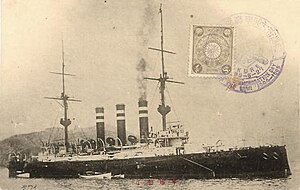 A postcard of Iwate at anchor, 1905
| |
| History | |
|---|---|
| Name | Iwate |
| Namesake | Mount Iwate |
| Ordered | 19 July 1898 |
| Builder | Armstrong Whitworth, United Kingdom |
| Laid down | 11 November 1898 |
| Launched | 29 March 1900 |
| Completed | 18 March 1901 |
| Reclassified |
|
| Stricken | 30 November 1945 |
| Fate |
|
| General characteristics | |
| Class and type | Izumo-class armored cruiser |
| Displacement | 9,423 t (9,274 long tons) |
| Length | 132.28 m (434 ft) (o/a) |
| Beam | 20.94 m (68 ft 8 in) |
| Draft | 7.21 m (23 ft 8 in) |
| Installed power |
|
| Propulsion | 2 Shafts; 2 triple-expansion steam engines |
| Speed | 20.75 knots (38.43 km/h; 23.88 mph) |
| Range | 7,000 nmi (13,000 km; 8,100 mi) at 10 knots (19 km/h; 12 mph) |
| Complement | 672 |
| Armament |
|
| Armor |
|
Iwate (磐手) was the second and last Izumo-class armored cruiser (Sōkō jun'yōkan) built for the Imperial Japanese Navy (IJN) in the late 1890s. As Japan lacked the industrial capacity to build such warships herself, the ship was built in Britain. She participated in most of the naval battles of the Russo-Japanese War of 1904–1905. The ship was moderately damaged during the Battle of Port Arthur, the Battle off Ulsan, and the Battle of Tsushima. Iwate played a minor role in World War I and began the first of her many training cruises for naval cadets in 1916, a task that would last until the end of 1939. The ship continued to conduct training in home waters throughout the Pacific War. Iwate was sunk by American carrier aircraft during the attack on Kure in July 1945. Her wreck was refloated and scrapped in 1946–1947.